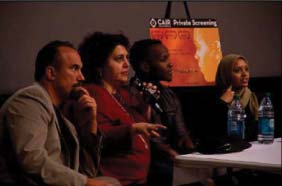Mooz-Lum’: A Muslim-American Perspective in Film
By Anna Almendrala

CAIR-LA Communications Manager Munira Syeda moderated Q&A following
CAIR-LA’s private film screening of ‘Mooz-lum.’ Actor Roger Guenveur
Smith (left), Producer Dana Offenbach and Director Qasim “Q” Basir participated
in the Q&A
On one hand, Mooz-Lum has the structure of a standard college movie. Protagonist Tariq (played by Evan Ross) struggles through an identity crisis by distancing himself from his family and strict religious upbringing.
As soon as he gets on campus, he experiments with alcohol, parties, and the opposite sex. But the film centers on an African-American Muslim family in Dearborn, Michigan, and the hedonistic college quarter is cut short by the tragic events of 9/11. Tariq, who wavers between ambivalence and hostility to the Muslim faith, must decide whether to fade into the background or stand up for his friends and family against a tide of anti-Muslim violence.
Director Qasim Basir freely admits that the movie is autobiographical. At 30 years old, he would have been around 20 on September 11, 2001. Like many Muslims around the United States, he was torn between both grief for the victims of the terrorist attack and a feeling of apprehension for his own safety in the weeks and months immediately following 9/11.
As he put it in his Huffington Post blog last year, “We have to live in fear not only of terrorists but also of being associated with them.” And at a private screening of his movie hosted by CAIR-LA last weekend, he shares what moved him to write Mooz-Lum: after 9/11, someone tried to hit his sister’s best friend with a car because she was wearing a hijab (scarf). Basir explained to the audience, “As she jumped out of the way, they sped by and yelled out a slur to her. That really stayed with me.”

CAIR-LA Executive Director Hussam Ayloush with Director Qasim Basir and
actor Roger Smith at the film screening in City of Orange
The sold-out theater in Orange, California was full of young Muslim families with children, college students, and congregants from nearby mosques. Throughout the film, many in the audience reacted viscerally and vocally to what they saw on the screen. Mothers tsk-tsked in disapproval when they saw Tariq toss his kufi (skullcap) out the window of his car. There was frequent applause throughout much of the film, usually after an impassioned speech in defense of the faith. The brief, jarring depictions of violence were so harrowing that exhales of relief from the audience was near-audible. And after the event, people streamed out of the theater beaming, exhilarated, and visibly relieved to see a relatable Muslim-American storyline on the big screen.
Ramy Rashad, a freshman at USC, identified deeply with the film’s college setting and the difficult adjustment period some Muslim American students experience in university. “I thought it was amazing, inspiring, and very truthful. I’m a college student myself, and I’ve seen some students go through what he’s gone through.”
Teenager Fatima Abdelhafeez reacted strongly to the film’s depiction of post-9/11 bigotry against Muslim Americans. Though she was only six on the day of the attacks, she remembers feeling both affected by the deaths of her fellow-citizens and shut out of the national grieving process. She explained, “I’m an American too, and those are my neighbors who died.” But the looks she and her mother got for wearing a hijab made her feel as if she didn’t belong in the United States.
The movie wears its heart on its sleeve, as Variety points out: “The very title, a play on the common mispronunciation of Muslim, should serve as fair warning that subtlety is not a strong point here.” The Examiner also mentions that the film “may be guilty of one-too many flashbacks” in an effort to tell Tariq’s backstory. Despite all this, Mooz-Lum’s groundbreaking depiction of Muslims in America is a welcome breath of fresh air, and Qasim Basir is a leader in a burgeoning movement of young Muslim-Americans finding their voice in the film and media industry.
Producer Dana Offenbach, who was also on the panel, had this to say about the movie: “In the last several years in this country, there have been 79 or 80 films with a Muslim character in it. The percentage of those characters who were terrorists or villains is overwhelming. It’s about 90-something percent, and the other 5-8% is a minor role that was basically ineffective. Aren’t you glad that he did this film?”
The film is being shown in eleven theaters around the United States. To find a location near you and purchase tickets, visit Mooz-Lum The Movie. - Huffington Post, February 15, 2011

